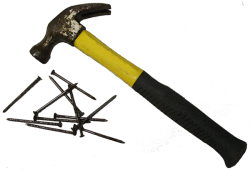Common Definition: A 16 penny nail. The size of a framing nail used to fasten studs, plates and joists together.
 Unauthorized Definition: The penny, symbol “d”, refers to nail size. Penny is a confusing term based on obsolete traditions, but it’s still used daily. Carpenters don’t call a nail that is one inch long, a “one inch nail”. No, that’s too logical. Besides, how could they tell the salty journeyman from the crass beginner? Instead a 1″ nail is really a 2d nail. Nail length increases with the number. A 2d (1″) nail is smaller than a 16d (3-1/2”) nail.
Unauthorized Definition: The penny, symbol “d”, refers to nail size. Penny is a confusing term based on obsolete traditions, but it’s still used daily. Carpenters don’t call a nail that is one inch long, a “one inch nail”. No, that’s too logical. Besides, how could they tell the salty journeyman from the crass beginner? Instead a 1″ nail is really a 2d nail. Nail length increases with the number. A 2d (1″) nail is smaller than a 16d (3-1/2”) nail.
Sound Like a Pro: Most professionals say “16 penny nail” and not “16 dee nail”. Choosing the correct nail length and type are critical for quality construction. Craftspeople pride themselves on employing the right nail for every occasion. That’s why referring to nails correctly is important for appearing knowledgeable, as a homeowner or seasoned professional. The last thing you want to ask a hardware clerk for are 3-1/2” nails. You’ll be sent to the beauty store. It’s better to gruffly mumble, “give me two pounds of 16 penny nails”.
Not only size, but type is important. Common nails have big flat heads and they’re used for framing. Finish nails fasten trim, because they have small heads. When countersunk (driven past the wood surface) these small heads create an easily filled hole. Drywall nails hold drywall to framing.
Today’s nails are round because of mass production. However, masonry nails are still square and tempered for extra strength. Old handmade nails, even for framing were square. If you find square nails when remodeling an old home, call Ebay. Collectors consider these nails a real treasure.
Exterior grade nails are coated or made of non corroding metal. Hot dipped or galvanized nails are exterior grade. A typical, but serious problem with do-it-yourselfers is using interior nails for outside projects, where they quickly rust. Or they use steel nails to attach aluminum flashing. Mixing metals can hasten corrosion.
Fun Trivia: The term “Penny” originally came from the old English custom of selling nails by the hundred. A hundred nails selling for 16 pence was a 16 penny nail. Larger nails cost more per 100, thus the larger number means a larger nail. The symbol “d” is an abbreviation for the British penny derived from the denarius an old Roman coin. So every time you order nails curse the Romans first, then the Brits. Today, nails are typically sold by the pound or box. But the penny designation still describes nail size.
Spikes are larger versions of common nails used for timbers, etc. Spikes range from 30d (4-1/2”) to 60d (6”). Any spike larger than 60d is described by its actual length, the longest being 12 inches and used primarily for killing vampires.
Brads and tacks on the other hand are small nails. They’re used for cabinetry, upholstery and practical jokes like nailing a subcontractor’s shoes to the floor. Or watching someone jump out of their seat shortly after sitting.
Screws are replacing nails in many applications. It’s now common to screw drywall for better holding power. Sub floors are often screwed and glued to minimize creeks. Even decking is attached with exterior grade finish screws or ring shank nails. Ring shanks, or nails with rings along the shank, are a cross between screws and nails. With rings, they holds better than smooth nails. But are also harder to hammer into place.
« Back to Glossary Index